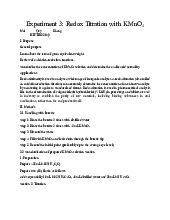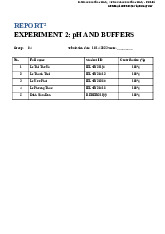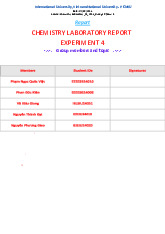















































































Preview text:
! ! ! Lab Manual General Chemistry ! ! ! ! 2022!-!2023! ! ! ! ! ! ! ! !
International*University,*Vietnam*National*University*-*HCMC!
GENERAL!CHEMISTRY!LABORATORY! Page*2** ! Contents'
Contents ............................................................................................................................................................................. 2
ACKNOWLEDGEMENTS ....................................................................................................................................................... 5
Preface ............................................................................................................................................................................... 6
Editorial Team .................................................................................................................................................................... 7
LABORATORY SAFETY GUIDELINES ...................................................................................................................................... 8
A. CLOTHING ............................................................................................................................................................................. 8
B. HANDLING CHEMICALS ......................................................................................................................................................... 8
C. HANDLING EQUIPMENTS ...................................................................................................................................................... 9
D. BEHAVIORS ........................................................................................................................................................................... 9
E. EMERGENCY PROCEDURES ................................................................................................................................................... 9
SAFETY AGREEMENT ......................................................................................................................................................... 10
MAKE-UP LAB FORM ......................................................................................................................................................... 11
COMMON LAB TECHNIQUES ............................................................................................................................................. 12
COMMON LABORATORY GLASSWARE AND EQUIPMENT .......................................................... Error! Bookmark not defined.
EXPERIMENT 1 3 Chemical Reactions ................................................................................................................................ 13
OBJECTIVES ............................................................................................................................................................................. 13
1. INTRODUCTION .................................................................................................................................................................. 13
2. PROCEDURE ........................................................................................................................................................................ 14
2.1. REACTIONS OF Cu2+ ..................................................................................................................................................... 14
2.2. REACTIONS OF SILVER HALIDES .................................................................................................................................. 14
2.3. REACTIONS OF H2O2 .................................................................................................................................................... 15
2.4. REACTIONS OF KMnO4 ................................................................................................................................................ 16
2.5. REACTIONS OF Fe2+ and Fe3+ ....................................................................................................................................... 16
2.6. REACTIONS OF Al3+ ...................................................................................................................................................... 17
2.7. FLAME TEST ................................................................................................................................................................. 18
3. SUGGESTED QUESTIONS ..................................................................................................................................................... 20
4. DATASHEET ......................................................................................................................................................................... 20
5. REPORT ............................................................................................................................................................................... 20
Experiment 2: pH and Buffers ........................................................................................................................................... 21 2
International*University,*Vietnam*National*University*-*HCMC!
GENERAL!CHEMISTRY!LABORATORY! Page*3**
OBJECTIVES ............................................................................................................................................................................. 21
1. INTRODUCTION .................................................................................................................................................................. 21
2. PROCEDURE ........................................................................................................................................................................ 24
2.1. DEIONIZED WATER ...................................................................................................................................................... 24
2.2. STRONG ACID .............................................................................................................................................................. 24
2.3. WEAK ACID .................................................................................................................................................................. 25
2.4. SALTS ........................................................................................................................................................................... 26
2.5. BUFFERS ...................................................................................................................................................................... 26
3. SUGGESTED QUESTIONS ..................................................................................................................................................... 28
4. DATASHEET ......................................................................................................................................................................... 29
5. REPORT ............................................................................................................................................................................... 29
Experiment 3: Redox Titration with KMnO4 ....................................................................................................................... 30
OBJECTIVES ............................................................................................................................................................................. 30
1. INTRODUCTION .................................................................................................................................................................. 30
2. PROCEDURE ........................................................................................................................................................................ 31
2.1. HANDLING WITH BURETTE .......................................................................................................................................... 31
2.2. STANDARDIZATION OF PREPARED KMNO4 SOLUTION ................................................................................................ 32
2.3. DETERMINATION OF UNKNOWN CONCENTRATION H2C2O4 SOLUTION ..................................................................... 32
2.4. DETERMINATION OF UNKNOWN CONCENTRATION FeSO4 SOLUTION ....................................................................... 34
3. SUGGESTED QUESTIONS ..................................................................................................................................................... 35
4. DATASHEET ......................................................................................................................................................................... 35
5. REPORT ............................................................................................................................................................................... 35
Experiment 4: Chemical Equilibrium .................................................................................................................................. 36
OBJECTIVES ............................................................................................................................................................................. 36
1. INTRODUCTION .................................................................................................................................................................. 36
2. PROCEDURE ........................................................................................................................................................................ 37
2.1. ACID/BASE EQUILIBRIA ................................................................................................................................................ 37
2.2. EQUILIBRIA OF ACID/BASE INDICATORS ..................................................................................................................... 38
2.3. EQUILIBRIA OF PRECIPITATION REACTIONS ................................................................................................................ 39
2.4. TEMPERATURE EFFECTS ON EQUILIBRIA ..................................................................................................................... 40
3. SUGGESTED QUESTIONS ..................................................................................................................................................... 41
4. DATASHEET ......................................................................................................................................................................... 42
5. REPORT ............................................................................................................................................................................... 42
Experiment 5: Factors Affecting Reaction Rate .................................................................................................................. 43
OBJECTIVES ............................................................................................................................................................................. 43
1. INTRODUCTION .................................................................................................................................................................. 43
2. PROCEDURE ........................................................................................................................................................................ 43
2.1. EFFECT OF CONCENTRATION ON REACTION TIME ...................................................................................................... 43
2.3. EFFECT OF A CATALYST ON THE REACTION RATE ........................................................................................................ 48
3. SUGGESTED QUESTIONS ................................................................................................................................................ 49 3
International*University,*Vietnam*National*University*-*HCMC!
GENERAL!CHEMISTRY!LABORATORY! Page*4**
4.#DATASHEET ....................................................................................................................................................................... 50
5.#REPORT .............................................................................................................................................................................. 50
APPENDIX(A .................................................................................................................................................................... 51
A1. The Oxidation Numbers of Some Common Cations .......................................................................................................... 65
A2. The Oxidation Numbers of Some Common Anions ........................................................................................................... 66
A3. Activity Series of Common Metals .................................................................................................................................... 67
LAB PREPARATION ............................................................................................................................................................ 68
1. Chemicals ............................................................................................................................................................................ 68 o
EXPERIMENT 1 ........................................................................................................................................................... 68 o
EXPERIMENT 2: .......................................................................................................................................................... 68 o
EXPERIMENT 3 ........................................................................................................................................................... 69 o
EXPERIMENT 4 ........................................................................................................................................................... 69 o
EXPERIMENT 5 ........................................................................................................................................................... 69
2. Equipment .......................................................................................................................................................................... 70 o
EXPERIMENT 1 ........................................................................................................................................................... 70 o
EXPERIMENT 2 ........................................................................................................................................................... 70 o
EXPERIMENT 3 ........................................................................................................................................................... 70 o
EXPERIMENT 4 ........................................................................................................................................................... 70 o
EXPERIMENT 5 ........................................................................................................................................................... 71
APPENDIX B ...................................................................................................................................................................... 72
LAB STRUCTURE ...................................................................................................................................................................... 72
TERMINOLOGY ......................................................................................................................... Error! Bookmark not defined.
MATERIAL SAFETY DATA SHEETS (MSDS) .......................................................................................................................... 73
Acetic acid MSDS .................................................................................................................................................................... 75
REFERENCES ...................................................................................................................................................................... 78 ' ' 4
International*University,*Vietnam*National*University*-*HCMC!
GENERAL!CHEMISTRY!LABORATORY! Page*5** ACKNOWLEDGEMENTS' To-be updated! ' 5
International*University,*Vietnam*National*University*-*HCMC!
GENERAL!CHEMISTRY!LABORATORY! Page*6** Preface'
This laboratory manual is designed to fulfill the types of chemistry courses in the International University.
The Data and Report Sheets are attached in the appendix and can be downloaded on the class Blackboard
page (https://blackboard.hcmiu.edu.vn/...). The students are directed to enter data into the Data Sheets
during the experiment, then copy the finished data and calculations into the Report Sheet. This results in a
clean and neat report. Report sheets are designed to give an adequate presentation of observations and results
but short enough to be graded easily and rapidly. Each experiment is independent of the others.
All experiments must be completed in a five-hour laboratory period, including a pre-laboratory discussion.
A student finishing a laboratory course will be familiar with several laboratory operations and will learn
how to collect and analyze experimental data. These skills will be a strong foundation for further work in
general chemistry or another college-level science curriculum. The Editorial Gen-Chem Team ' 6
International*University,*Vietnam*National*University*-*HCMC!
GENERAL!CHEMISTRY!LABORATORY! Page*7** Editorial'Team'
This laboratory manual cannot be done without the Gen-Chem Editorial Board at the International University HUþNH KIM LÂM EDITOR-IN-CHIEF Assoc. Prof. + Chief editing Ph.D. in Physical Chemistry LÊ NGUYÞN THIÊN PHÚC MANAGING EDITOR M.Sc. in Marine Biotechnology
+ Content creating & editing - Experiments + Overall content editing PHÙNG THANH KHOA SENIOR EDITOR Ph.D. + Section editing
in Materials Science & Technology - Experiments + Overall content editing NGUYÞN NGÞC ÁNH EDITOR B.Sc. in Biotechnology
+ Content creating & editing B.L. in Civil Law - Equipment + Overall layout editing NGUYÞN PHÚC NGUYÊN ASSISTANT EDITOR B.Eng. in Food Technology + Section editing - Terminology + Proofreading NGUYÞN >Þ XUÂN AN ASSISTANT EDITOR B.Eng. in Food Technology + Section editing - Chemicals - Forms & Templates + Proofreading 7
International*University,*Vietnam*National*University*-*HCMC!
GENERAL!CHEMISTRY!LABORATORY! Page*8**
LABORATORY'SAFETY'GUIDELINES' !
If you do not have time to do things correctly and safely, with adequate time for thought, please stay away from the laboratory. A.!CLOTHING!!
1. WEAR APPROVED EYE PROTECTION AT ALL TIMES. Very minor laboratory accidents, such as the splattering of solution, can
cause permanent eye damage. Wearing laboratory goggles can prevent this eye damage. In the chemistry teaching laboratories
safety glasses (goggles) of an approved type must be worn by all persons in the room at all times that anyone is working with
or transporting glassware or conducting any experimental work. Experimental work includes simple tasks such as transporting
chemicals or glassware, obtaining quantitative measurements that involve non-sealed containers, etc. Lightweight 88visitors9
shields99 or prescription glasses with side shields are acceptable only for laboratory visitors if your institution permits them but
are not suitable for routine laboratory work.
2. WEAR PROPER PROTECTIVE CLOTHING. Proper protective clothing must be worn by all persons in the room at all times that
anyone is working with or transporting glassware or conducting any experimental work. Exposed skin is particularly susceptible
to injury by splattering of hot, caustic, or flammable materials. Students and instructors need to be protected from their necks
to below their knees. This requirement includes no shorts, no short skirts, no sleeveless garments, and no bare midriffs. Long
lab coats or aprons are required if shorts or short skirts are worn. Makeshift coverage such as shirts being used as aprons, paper
taped over the knees, etc., is not considered to be suitable. Tight fitting clothing, long unrestrained hair, clothing that contains
excessive fringe or even overly loose-fitting clothing may be ruled to be unsafe. Long hair must be tied back and no dangling jewelry.
3. WEAR PROPER PROTECTIVE FOOTWEAR No sandals/flip-flops, no open-toed shoes, and no foot covering with absorbent
soles are allowed. Any foot protection that exposes any part of one9s toes is unsuitable for wear in the laboratory. B.!HANDLING!CHEMICALS!
4. NEVER WORK IN A CHEMICAL LABORATORY WITHOUT PROPER SUPERVISION. Your best protection against accidents is the
presence of a trained, conscientious supervisor, who is watching for potentially dangerous situations and who is capable of
properly handling an emergency
5. NEVER INHALE GASES OR VAPORS UNLESS DIRECTED TO DO SO. If you must sample the odor of a gas or vapor, use your
hand to waft a small sample toward your nose.
6. EXERCISE PROPER CARE IN HEATING OR MIXING CHEMICALS. Be sure of the safety aspects of every situation in advance. For
example, never heat a liquid in a test tube that is pointed toward you or another student. Never pour water into a concentrated
acid. Proper dilution technique requires that the concentrated reagent be slowly poured into water while you stir to avoid localized overheating.
7. NEVER EAT, DRINK, OR SMOKE IN A CHEMICAL LABORATORY. Tiny amounts of some chemicals may cause toxic reactions.
Many solvents are easily ignited. Food and drinks are never allowed in the labs. This includes all visible insulated water bottles
or mugs, containers of water or flavored drinks, containers of ice intended for consumption, etc. If a food or drink container is
empty or unopened, it needs to be inside a backpack, etc., and out of sight.
8. NEVER RETURN RESIDUE CHEMICALS TO THEIR ORIGINAL CONTAINERS. Used chemicals might contaminate the original
chemical, thus never return them to their original containers. 8
International*University,*Vietnam*National*University*-*HCMC!
GENERAL!CHEMISTRY!LABORATORY! Page*9** C.!HANDLING!EQUIPMENT!
9. BE CAREFUL WITH GLASS EQUIPMENT. Cut, break, or fire-polish glass only by approved procedures. If a glass-inserter tool is
not available, use the following procedure to insert a glass rod or tube through a rubber or cork stopper. Lubricate the glass
and the stopper, protect your hands with a portion of a lab coat or a towel, and use a gentle twisting motion to insert the glass tube or rod.
10. NEVER PIPET BY MOUTH. Always use a mechanical suction device for filling pipets. Reagents may be more caustic or toxic than you expect.
11. USING INSTRUMENTS. Before using any instruments in the lab, read the manual carefully. Ask the instructor or lab technician if needed. D.!BEHAVIORS!!
12. NEVER PERFORM AN UNAUTHORIZED EXPERIMENT. 88Simple99 chemicals may produce undesired results when mixed. Any
experimentation not requested by the laboratory manual or approved by your instructor may be considered to be unauthorized experimentation.
13. NO REMOVAL OF CHEMICALS OR EQUIPMENT FROM THE LABORATORY. The removal of chemicals and/or equipment from
the laboratory is strictly prohibited and is grounds for severe disciplinary action.
14. NO HORSEPLAY. Horseplay and pranks do not have a place in instructional chemistry laboratories.
15. NO LAPTOPS, TABLETS, ETC. Laptops and tablets (iPad, tab ...) are not allowed in the lab. Only notebooks and pens/pencils are allowed.
16. CLEANING. Wash hands with soap and water after performing all experiments. Clean (with detergent powder), rinse, and
dry all work surfaces and equipment at the end of the experiment. E.!EMERGENCY!PROCEDURES!
17. KNOW THE LOCATION AND USE OF EMERGENCY EQUIPMENT. Find out where the safety showers, eyewash spray, and fire
extinguishers are located. If you are not familiar with the use of emergency equipment, ask your instructor for a lesson.
18. DON9T UNDER-REACT. Any contact of a chemical with any part of your body may be hazardous. Particularly vulnerable are
your eyes and the skin around them. In case of contact with a chemical reagent, wash the affected area immediately and
thoroughly with water and notify your instructor. In case of a splatter of chemical over a large area of your body, don9t hesitate
to use the safety shower. Don9t hesitate to call for help in an emergency.
19. DON9T OVER-REACT. In the event of a fire, don9t panic. Small, contained fires are usually best smothered with a pad or
damp towel. If you are involved in a fire or serious accident, don9t panic. Remove yourself from the danger zone. Alert others
of the danger. Ask for help immediately and keep calm. Quick and thorough dousing under the safety shower often can minimize
the damage. Be prepared to help, calmly and efficiently, someone else involved in an accident, but don9t get in the way of your
instructor when he or she is answering an emergency call.
These precautions and procedures are not all you should know and practice in the area of laboratory safety. The best insurance
against accidents in the laboratory is thorough familiarity and understanding of what you9re doing. Read experimental
procedures before coming to the laboratory, take special note of potential hazards and pay particular attention to advice about safety.
Take the time to find out all the safety regulations for your particular course and follow them meticulously. Remember that
unsafe laboratory practices endanger you and your neighbors. If you have any questions regarding safety or emergency
procedures, discuss them with your instructor. Then sign and hand in the following safety agreement. 9
International*University,*Vietnam*National*University*-*HCMC!
GENERAL!CHEMISTRY!LABORATORY! Page*10** SAFETY'AGREEMENT'
I have carefully read and understood the laboratory guideline printed above for working in the lab 501. It is my
responsibility to observe them and agree to abide by them throughout my laboratory working course. I hereby take
the full responsibility for my experiments and commit a compensation claim for any failure from my working time in the lab.
Signature: ________________________________________________________________________
Print Name: __________________________ Student9s ID: _________________________________
Phone: ______________________________ Email: _______________________________________
Date: ____________________________________________________________________________
Course: ______________________________Session: _____________________________________
Instructor: ___________________________ TA: _________________________________________
Person(s) who should be notified in the event of an accident:
Name: _________________________________
Phone: _________________________________
Email: _________________________________ Mailing Address:
________________________________________________________________________
________________________________________________________________________
________________________________________________________________________
________________________________________________________________________ 10
International*University,*Vietnam*National*University*-*HCMC!
GENERAL!CHEMISTRY!LABORATORY! Page*11** MAKEUP'LAB'FORM'
In order to make up a missed lab:
¥ Fill out the middle of the form below
¥ Have your Instructor/TA sign it. Your Instructor/TA MUST sign the form BEFORE you attend the makeup lab.
¥ Give it to the Hosting Instructor for the section you attend to make up the lab. Note: If a section is full, students
registered for the lab have priority. It is the Hosting Instructor9s discretion as to whether there is enough room for
you to attend when the lab is full. EVEN WITH the Instructor9s signature, the Hosting Instructor is NOT required to
allow you to attend that lab as a makeup.
¥ Make sure your name is on the group list for the day.
The following are approved reasons for missing and making up a lab. Mark the reason for your request: University-sponsored events Illness Family emergency
Other: _____________________________________________________________
Student Name: ___________________________ Student9s ID: _______________________
Lab Session for which student is officially registered:
Instructor9s Name: _____________________
Lab Session number: _____________________
(If you don't know your section number, circle the day and time your lab meets) Day: M T W Th F Sa Time: Morning Afternoon
Lab Session for which student plans to do the make-up experiment
Hosting Instructor9s Name: _____________________
Lab Session number: ___________________________
If you do not know the section number, circle the day and time the lab meets) Day: M T W Th F Sa Time: Morning Afternoon
_______________________________________________________________________________________ Signature of your Instructor Date
For the Hosting Instructor9s Use Only:
Lab Session:_________ Date: ___________ Time:___________ Grade Received: ____________________
Signature of the Hosting Instructor ! 11
International*University,*Vietnam*National*University*-*HCMC!
GENERAL!CHEMISTRY!LABORATORY! Page*12** COMMON'LAB'TECHNIQUES'
Please see the video clips on essential lab techniques on the course website
https://sites.google.com/view/genchemlab/ ¥ Chemical preparation ¥ Dilution ¥ Titration ¥ Acid handling ¥ Calibration of pH meter ¥ Pipetting technique ' ' ' 12
International*University,*Vietnam*National*University*-*HCMC!
GENERAL!CHEMISTRY!LABORATORY! Page*13**
Experiment'1'3'Chemical'Reactions'
Student name: ___________________________________________ ID: ___ _____________________________ OBJECTIVES!!
¥ To perform different types of chemical reactions, including acid-base, precipitation, gas forming, complex
compound forming and oxidation-reduction reactions.
¥ To identify the products in these reactions and describe the chemical changes.
¥ To write and balance the chemical equations for the reactions observed. 1.!INTRODUCTION!
Matter can undergo both physical and chemical changes. Chemical changes result in the formation of new
substances. When a chemical reaction occurs, substances called reactants are transformed into different substances
called products that often have different appearances and different properties. In this experiment, you will perform
and observe a number of chemical reactions. Observable signs of chemical reactions can be a change in color, the
formation of a solid, the release of gas, and the production of heat and light. You will also learn how to classify
chemical reactions. One classification system involves five general types of reactions: synthesis, decomposition,
single displacement, double displacement, and combustion. ! 13




